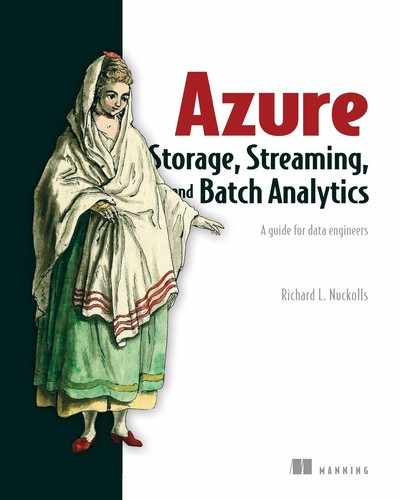0%
23Chapters
0-1Hours read
0kTotal Words
Book Description
Azure Storage, Streaming, and Batch Analytics shows you how to build state-of-the-art data solutions with tools from the Microsoft Azure platform. Read along to construct a cloud-native data warehouse, adding features like real-time data processing. Based on the Lambda architecture for big data, the design uses scalable services such as Event Hubs, Stream Analytics, and SQL databases. Along the way, you’ll cover most of the topics needed to earn an Azure data engineering certification.Table of Contents
- Azure Storage, Streaming, and Batch Analytic
- Copyright
- dedication
- brief contents
- contents
- front matter
- 1 What is data engineering?
- 2 Building an analytics system in Azure
- 3 General storage with Azure Storage accounts
- 4 Azure Data Lake Storage
- 5 Message handling with Event Hubs
- 6 Real-time queries with Azure Stream Analytics
- 7 Batch queries with Azure Data Lake Analytics
- 8 U-SQL for complex analytics
- 9 Integrating with Azure Data Lake Analytics
- 10 Service integration with Azure Data Factory
- 11 Managed SQL with Azure SQL Database
- 12 Integrating Data Factory with SQL Database
- 13 Where to go next
- appendix A. Setting up Azure services through PowerShell
- A.1 Setting up Azure PowerShell
- A.2 Create a subscription
- A.3 Azure naming conventions
- A.4 Setting up common Azure resources using PowerShell
- A.5 Setting up Azure services using PowerShell
- A.5.1 Creating a new Storage account
- A.5.2 Creating a new Data Lake store
- A.5.3 Create new Event Hub
- A.5.4 Create new Stream Analytics job
- A.5.5 Create new Data Lake Analytics account
- A.5.6 Create new SQL Server and Database
- A.5.7 Create a new Data Factory service
- A.5.8 Creating a new App registration
- A.5.9 Creating a new key vault
- A.5.10 Create new SQL Server and Database with lookup data
- appendix B. Configuring the Jonestown Sluggers analytics system
- index
